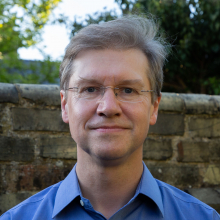2024 McDonnell Distinguished Lectures: Public Lecture with Christopher Reynolds on The “What, How, Where, and When” of Supermassive Black Holes
What is a black hole? If they are so black, how can they outshine whole galaxies? What impact do they have on the rest of the Universe? And where and when in the story of the Universe did supermassive black holes first emerge? These questions have engaged astrophysicists for over 50 years and motivated the construction of some of the most powerful observatories humanity have built. Reynolds will discuss the current state of knowledge on supermassive black holes, the monsters that are found at the center of essentially every galaxy in the Universe. Indeed, we have evidence-based answers to most of these questions apart from the most profound one… the origin of supermassive black holes. He will conclude by discussing the promise of the next generation of even more powerful observatories for solving this mystery.
Chris Reynolds is a Professor in the Department of Astronomy at the University of Maryland (UMD). He received his PhD from the University of Cambridge in 1996 and then conducted postdoctoral work at the University of Colorado before joining the Professorial Faculty at UMD in 2001. From 2017-2023, he held the position of Plumian Professor of Astronomy and Experimental Philosophy as at the University of Cambridge, serving as Deputy Director of the Institute of Astronomy there from 2018-2022. He returned to the Professorial Faculty at UMD in 2023 and is currently serving as Director of the UMD/NASA-Goddard Joint Space Science Institute (JSI). Reynolds leads a high-energy astrophysics research group with a broad focus on black holes and their related astrophysical processes.
Header image: An artist's impression of matter flowing into a black hole. The matter will naturally form a disk (the accretion disk) and, sometimes, a powerful jet will form along the rotation axis. Credit: NASA/JPL-Caltech


